# Business Process Manager Manual
# BPMN Introduction
# Which are the benefits?
**Which are the benefits?**
**Mapping the processes of your company allows you to:**
- improve the company efficiency;
- follow the procedures in a standard and univocal way;
- reduce human errors;
- reduce execution times;
- verify the existence of bottlenecks;
- reduce the time needed to learn procedures;
**Even the new arrival can learn in a fast and easy way how to manage the process avoiding to waste time and money.**
**To whom is the BPMN is adressed?**
To the people in charge of planning and managing the procedures whitin the company.
Below are listed the four fundamental graphic categories used in the BPMN:
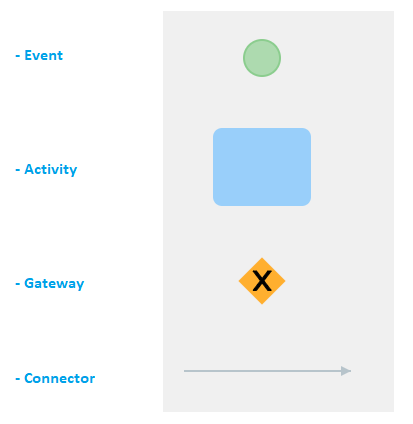
# Let’s see how the Business Process Manager works
To crate a process in vtenext the following steps must be followed
Click on:
- **1- Settings**
- **2- Process Manager**
- **3- New**
The following screen will open, you will have to indicate the name of the process and an eventual description.
There are two main choices, the first is to use an existing process using the **button import** or to create a new one by clicking on the button **create new**.


# Symbology
Here below the symbols to create a diagram:
[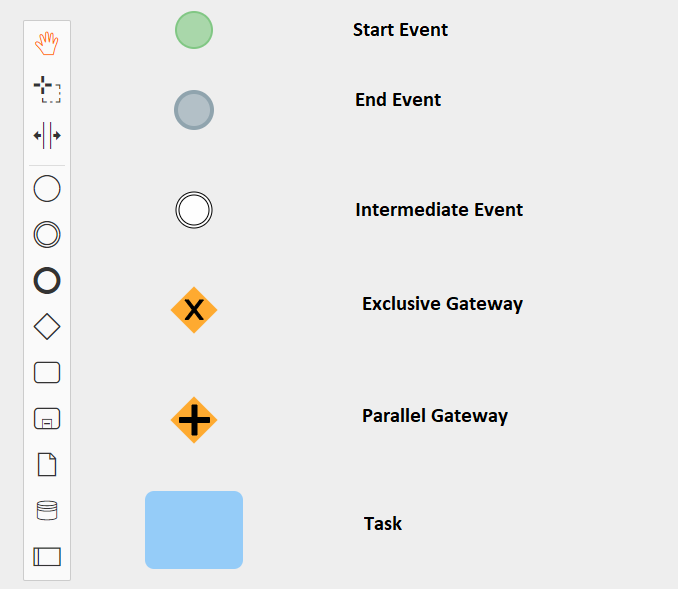](https://usermanual.vtenext.com/uploads/images/gallery/2020-10-Oct/symbology.PNG)
# Basic rules
Before seeing in detail the symbols used in vtenext is important to understand some fundamental rules for the graphical design of a process. Here below you can find and easy diagram and in the following slides a description for its configuration in vtenext.
In the diagram we begin from an initial event, the circle, the Connector, must have the same direction
as the flow. The Activity symbol is a Task that can be used both as Condition and Action.
- **1** -After the initial event there always must be a condition. Those are the conditions that make the flow go.
- **2** - Before the Getaway there always must be a condition that decides the sorting.
- **3** - After one or two conditions there are always different types of action (Script Task, Send Task, Manual Task, Human Task...)
- **4** - It would be useful to put an Activity before the End event.
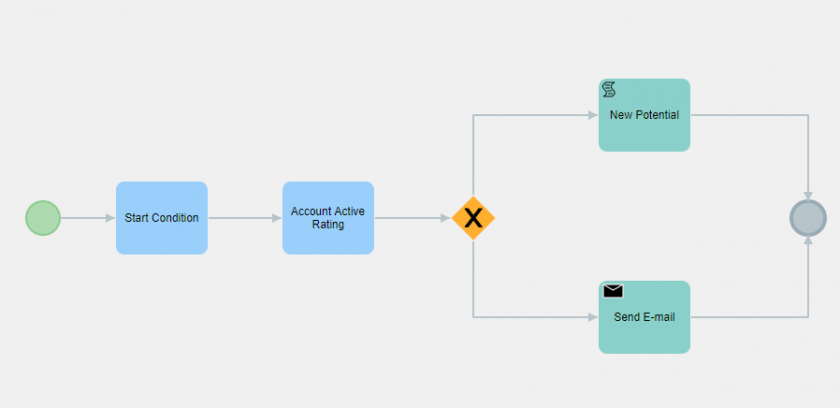

The **Start Event** is where the process begins, by clicking on it is possible to display the symbols reported on the left.
In red is displayed the wrench that allows to choose among the different symbols.
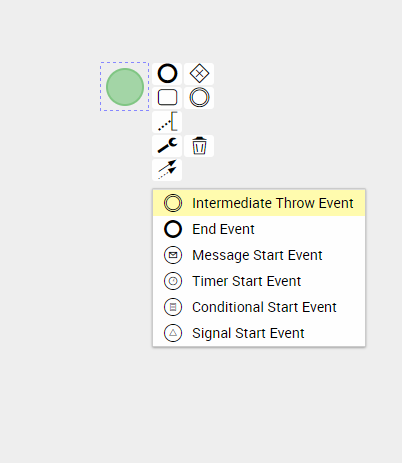
By clicking on **Intermediate Event** and then on the wrench the symbols reported on the wrench will be displayed.
An important tool is the Time Intermediate Catch Event, useful if there is the need to postpone an action.
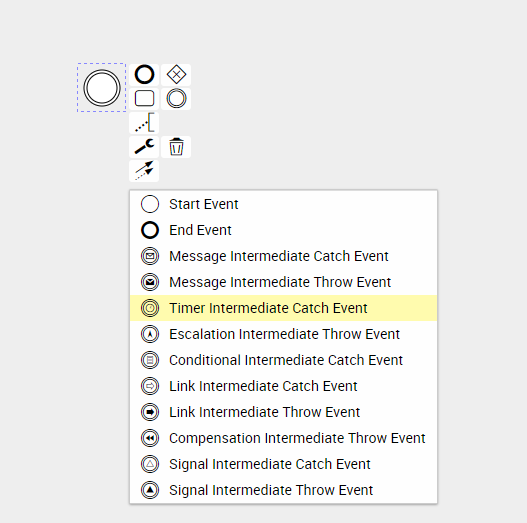

Here below an example of the **Timer Intermediate Catch Event** is reported. By positioning this symbol between the condition and the action, the sending of an email for example, it is possible to set the Timer and postpone its sending.
By clicking on the **Timer Intermediate Catch Event** symbol a screen will open, in which is possible to set the timer for the next action.
The next action waiting can be setted on:
- Now (datetime of process execution)
- Static date (static datetime)
- Dynamic date (process entity date field)
[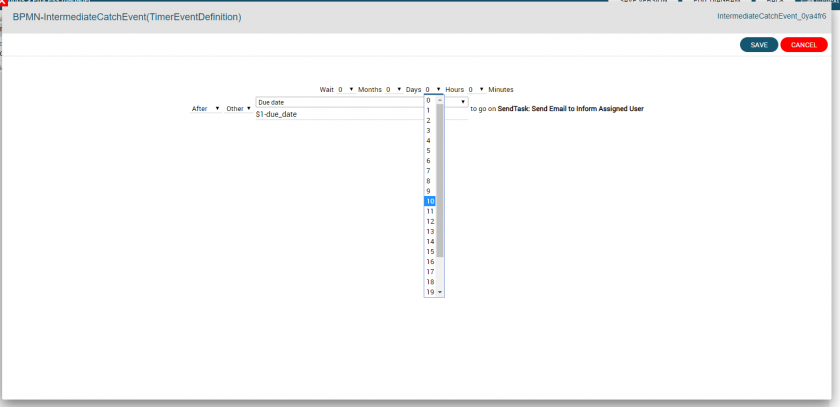](https://usermanual.vtenext.com/uploads/images/gallery/2019-10-Oct/Timer_intermediate_ENG.png)
The **End Event** will close the process, more than one can be used as the process can take different paths, or it can be the same End Event as a common end point of different paths.

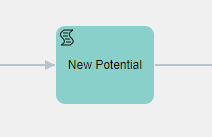
It is recommended to draw an action before the end point so it is clear how the process ends.
---
The Activity Task is represented by a rectangle, and indicates a condition or an action, the difference is that the latter is marked by a script.
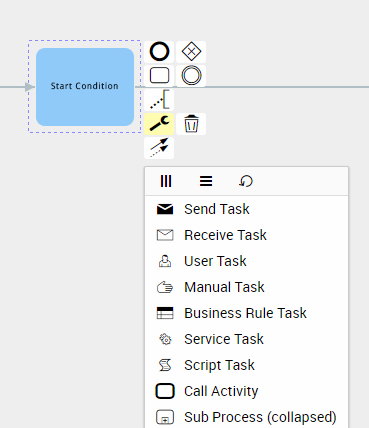
To create a task or an activity you have to click on the wrench and then chose the script that fits better. The symbols are used to identify the actions on a diagram level, during the configuration the procedures will be the same, except for the sub processes.
**Connecting object :**
In the process the elements of the flows (events, activities or ramifications) represents what actually happens, therefore they have to be logically connected. And to do so we use the connectors.
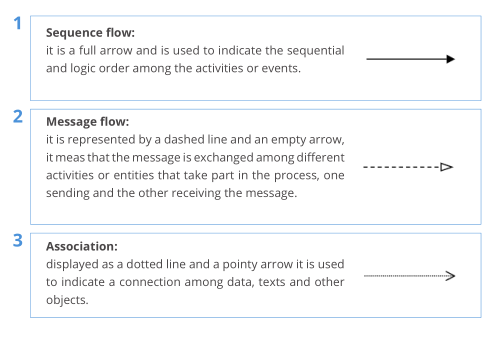
---
The symbol on the top left is the Gateway, at the moment only the Parallel and the Exclusive ones can be used.
The one with the big X is the Exclusive Gateway and is used when the process takes two or more different paths, that depends on the condition that is placed before the gateway. Doing so only the paths that meets the conditions will be
taken. Always by clicking on the wrench is possible to chose the Parallel Gateway.
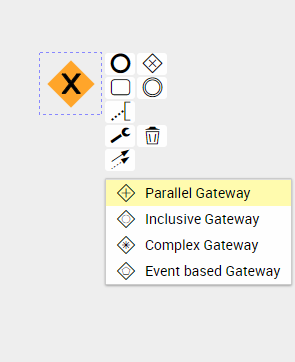
The Parallel Gateway is used when one or more conditions, but not all of them, have to be met to proceed with the process.
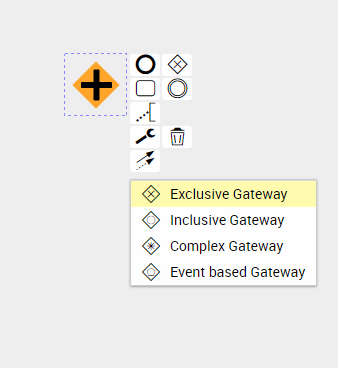
# BPMN Actions
# BPMN Actions
Below the main BPMN actions:
**1 - Create entity 2 - Update entity 3 - Delete entity 4 - Send notification 5 - Send email 6 - Send newsletter 7 - Create PDF 8 - Reset dynamic form 9 - Cycle rows 10 - Reset conditional fields 11 - Link entities 12 - Link static entities 13 - Transfer relations 14 - Insert table row 15 - Call external Web service
16 - Cycle Related Record**
**1 - Create entity:** This action allows to create record of system entities (standard or custom).
You can set a static or dynamic value for each one field (you can select values from involved process entities).

**2 - Update entity:** This action allows to update an involved process entity or related ones.
You can set static or dynamic value for each one field (you can select values from involved process entities).
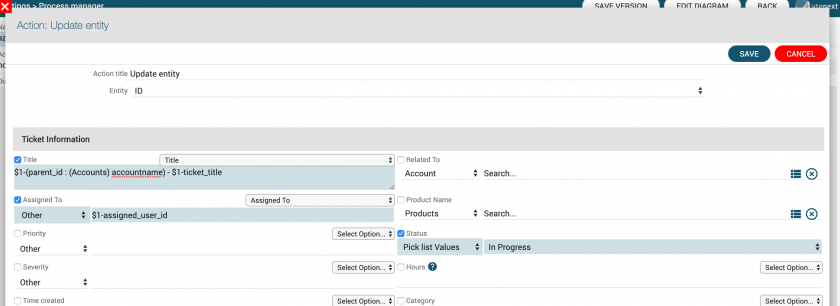
**3 - Delete entity:** This action allow to delete a dynamic entity, an involved process entity.
This action is used in conversion processes cases, ex. conversion from lead to contact/account (deleting lead after the conversion) or in error cases, ex. re-planning of activities with creation of new entities and deleting the old ones.

**4 - Send notification:** This action allow to send internal notification to the system users.
It's possible to set a specific text with static/dynamic data and relate entity. Besides, you can set the email parameters for the users that use email notification and not internal ones (you can change this settings into the user preference).

**5 - Send email:** This action allows to send email with static/dynamic data.
It's possibile to set a static/dynamic sender email address (you can select email fields from involved process entities).
The same configuration is available for the email recipients (ex. record assigned user email , involved process partecipants, ecc).
Besides, you can relate the email to an involved process entity (or related ones). In this case, it will be possible to see a new message into the related list.
In the body message you can insert static/dynamic values and other general functions like current date/time, desired entity link (internal one for users or external one for portal customers).
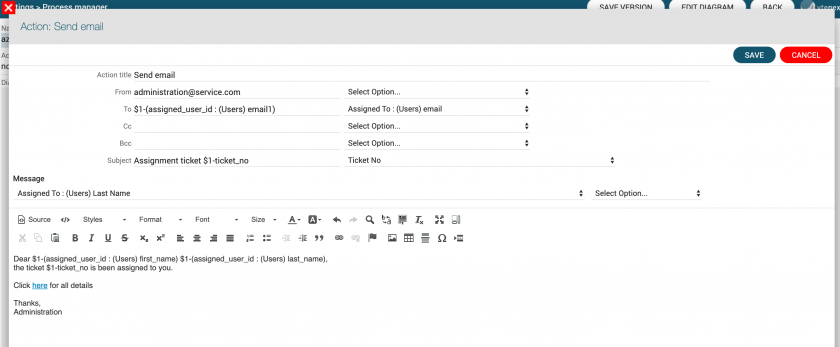
**6 - Send newsletter:** This action allow to send newsletter, so a massive email to pre-selected recipients. These ones can be static addresses or chosen from involved process entities, system targets.
It's possibile to set sender email address and name (alias), default template and a campaign (existing or new one)

**7 - Create PDF:** This action allow to create a PDF document using an existing template.
It's possibile to select the PDF entity, desired template, the entity to relate document, language, assigned user and document folder.

**8 - Reset dynamic form:** This action is based on ProcessHelper use and allows to clean its data off to re-use this one. So, it's used when the same Dynamic Form can be shown to the user many times. You need to clean its data to allow a new compilation.

**9 - Cycle rows:** This action is based on Table field use. This one is not available if involved process entities (and related ones) haven't got this field into the module layout editor.
For each one table field row (and specific column conditions) is possible to send emails, create new entities, insert new rows (into the same field or other ones), delete rows, send notifications.


**10 - Reset conditional fields:** This action is based on process conditional fields use.
Infact, it's possible to set conditional fields on the selected entity (involved into the process) or into the Dynamic form.
In the entity conditional fields case, these ones prevail over the general settings ones.
The last ones are disabled till the process end or an action task with "Reset conditional fields" action.

**11 - Link entities:** This action allows to link 2 entities each other those have a N - N relation.
The 2 entities haven't got the relation field but a N relation.

**12 - Link static entities:** This action allows to link a specific static entity to an involved process one.
It's useful when you have to link the same entity to many ones into the process, ex. link the same document (privacy policy, checklists, ecc.)

**13 - Transfer relations:** This action allows to transfer/copy the related entities from a process entity to an other one.
In the 1 - N relation case, the record will be transferred, while with N - N relation the record will be copied.
This action is useful in process conversion cases where the start entity is converted to an other one, so all its related entities can be transferred/copied to the new one.
Ex. In a conversion process from lead to contact/account all lead related entities can be transferred/copied to the new contact/account. At the end it's possible to delete the lead without any lost.

**14 - Insert table row:** This action is based on Table field use. This one is not available if involved process entities (and related ones) haven't got this field into the module layout editor.
This action allows to insert a new row into the specific table field.
The insert values can be statics/dynamics (you can select values from involved process entities).

**15 - Call external Web service:** This action allows to call a REST external Web service.
It's possible to set call data into the Settings -> Business Process Manager -> External Web services.
You have to fill the endpoint, authentication parameters and returned fields. When it's done it's possible to use them into a process.
In the process configuration you can set dynamic parameters (name and value), so the web service call will have got all static data (specified into general settings) and dynamic ones (specified into the process).
Into the flow it's possible to check if the web service call has been successfully with the 3 static parameters it returns (success, response code and message code). In addition, the call will get the configured returned fields.
In the complex response case (object with many attributes) is possible to extract them till one escalation level (using return field name and attribute, ex. object.attribute).
It's not supported a response object list.

**16 - Cycle Related Record**
This action allows to use the module related records, which are in a relation type of 1-N and N-N. For each rows of the related module is possible to perform the following actions: send an email, create an entity, update an entity, send notifications and create PDF. For the reason mentioned above in the configuration of the actions is possible to map inside the fields the values that came from the module related records.
[](https://usermanual.vtenext.com/uploads/images/gallery/2021-08-Aug/BPMN-actions_-cycle-related-records_1.PNG)
[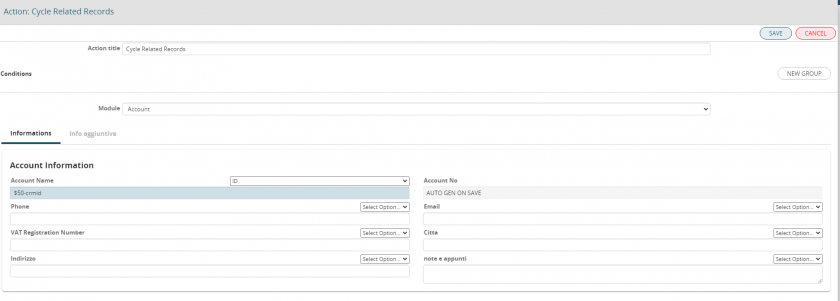](https://usermanual.vtenext.com/uploads/images/gallery/2021-08-Aug/BPMN-actions_-cycle-related-records_2.PNG)
# Basic Process Configuration
# Basic Process Configuration

**The process represented above is now described in detail.**
It is really easy:
the process starts every time a new company record is created and its Rating is checked.
Depending on that the flow takes two different paths.
If the value is set on “Active” a new Potential is created, otherwise an email is sent to the administration department to inform them of the company’s record creation.
---
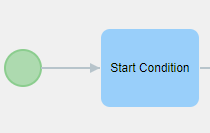
This process is designed to start every time a new company record is created. For that reason on “when to run the check” the option “on create” has been chosen.

---
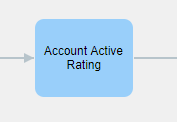
Once the process has been performed, we find this **Conditional Task**.
On “when to run the check” has been chosen the condition “every time the condition is true”; in this way there is
no need for a manual intervention of the user and the process continues every time the condition is true.
[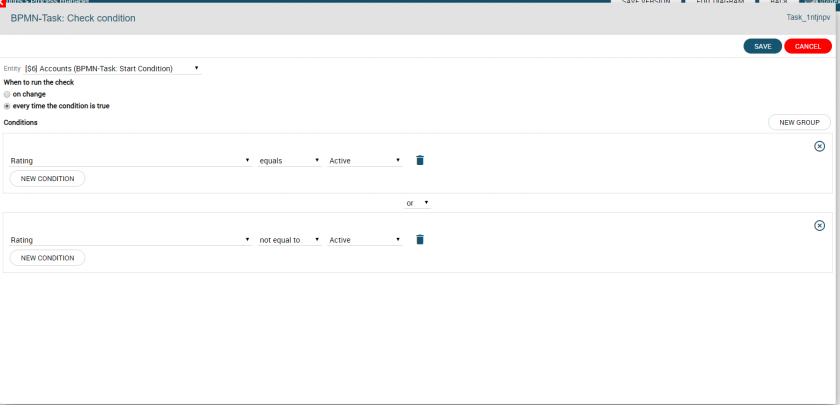](https://usermanual.vtenext.com/uploads/images/gallery/2019-10-Oct/AccountRating_ENG.PNG)
---
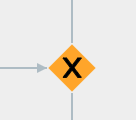
At this point the process is divided in different paths, considering the conditions previously set. Here in the previous
condition two groups of conditions were set (OR), for that reason we can see two different paths.
One of these (status Active Company Rating) will lead to the creation of a new Opportunity related to the company, the
other (Company Rating Non Attivo) will send an informative email.

#### **Let’s analyze the first:**
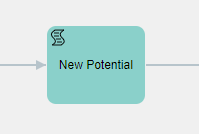
You create a ScripTask with the action **“Create entity”**, then you choose the module Potentials. It is recommended to always name the actions, in this case “New Potential”.
It is always recommended to give a reference name to the actions of the process, in this case “New Opportunity”.

Once the desired module is selected, in this case the “Potentials” one, all the related fields are shown. Those can be mapped by taking data from all the related entities, from the selected one and from all the entities connected to the process itself.
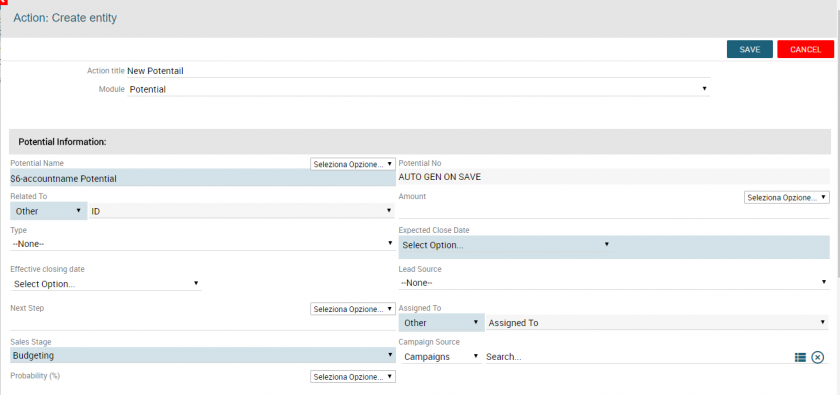
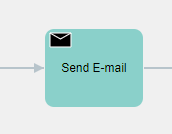
In the other path, an email that notifies the creation of the company record is sent.
We create a Send Task and the “Action” chosen is send email.
As previously sad it is highly recommended to give a name to every action, in this case is “New Company Email Send”.

Sender, Receiver, Subject and all the other classical information needed are displayed.
Every field can be mapped by taking the data from the different field of the entities recalled in the process.
In the body of the email it is possible to use some special functions that can be selected from the Pick list on the right.
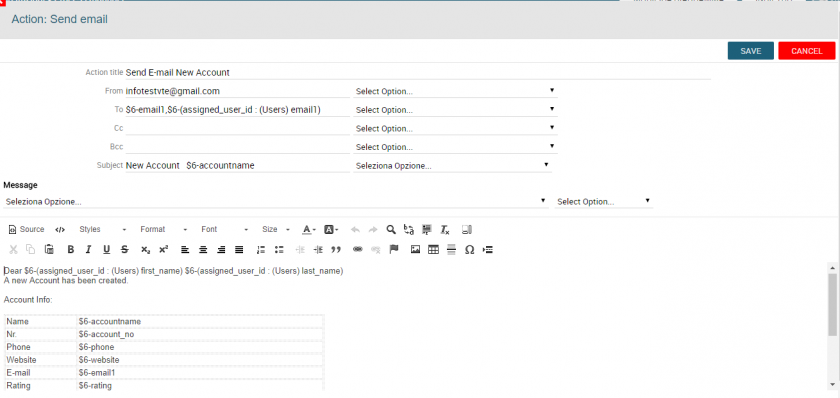

At this point, the process converge in one element, the End Event. Therefore the Ended Status is set.

**End of support service**
[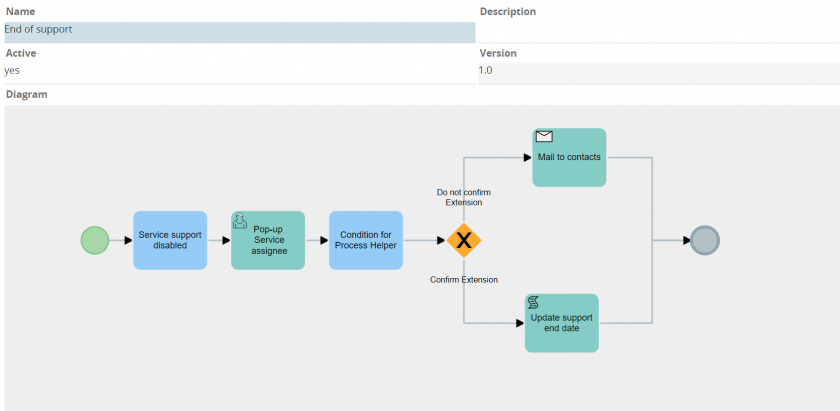](https://usermanual.vtenext.com/uploads/images/gallery/2021-08-Aug/Basic-Process-Configuration_-process-screenshoot_1.PNG)
The following process manage the end of of support service.
The description of the process is the following when a user check the field "end of the support" inside the Service module the assignee of that service will be notificed with a pop-up where is asked if he/she wants to extend the support or confirm the end. Depending on the choice made by the asignee the process will take two differents process branches.
[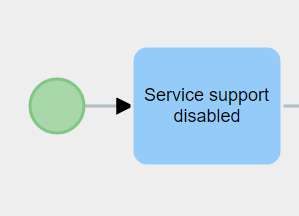](https://usermanual.vtenext.com/uploads/images/gallery/2021-08-Aug/Basic-Process-Configuration_-conditional-task-2.PNG)
[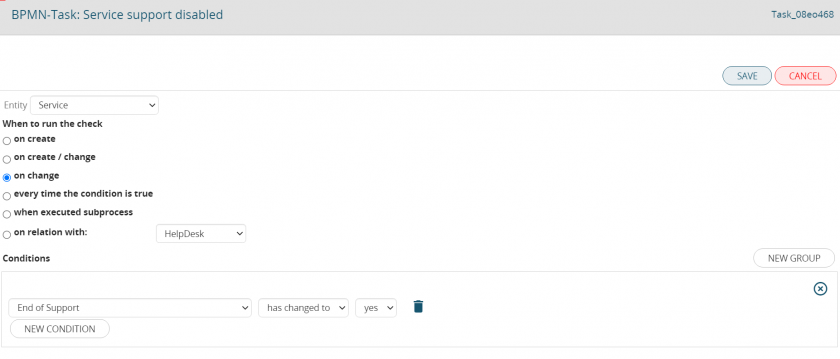](https://usermanual.vtenext.com/uploads/images/gallery/2021-08-Aug/Basic-Process-Configuration_-_conditional-task-2_configuration.PNG)
The process start when a user modify the field “End of Support” to the value “yes” within the module Service. This condition prevent that the process is trigered each time that any entity inside the module Service is modified.
[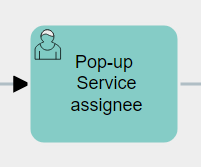](https://usermanual.vtenext.com/uploads/images/gallery/2021-08-Aug/Basic-Process-Configuration_-assignee-pop-up_3.PNG)
[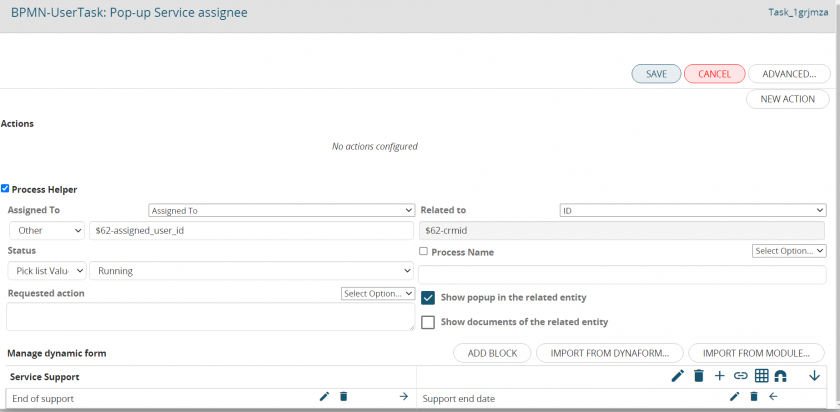](https://usermanual.vtenext.com/uploads/images/gallery/2021-08-Aug/Basic-Process-Configuration_-assignee-pop-up_3_configuration.PNG)
The process continues with a pop-up that ask to the asignee of the service if he/she wants to extend the support or if he/she wants confirm the end. The pop-up is made through an “user task” where is checked the box “process helper”. Inside the Process Helper configuration is set the person who will see the pop up as well as the linked entity and the message that will be displayed to the assignee. In addition the process helper has one section with two fileds: one to confirm the extension of the service support ( which is a check box that is set to mandatory) and the other “Support end date” ( which is a date field thtat is mandatory only in the case that the assignee confirm the extension of the service).
[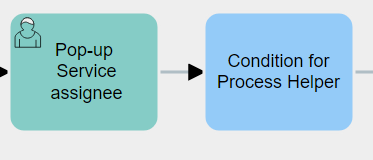](https://usermanual.vtenext.com/uploads/images/gallery/2021-08-Aug/Basic-Process-Configuration_-assignee-pop-up_3_2.PNG)
[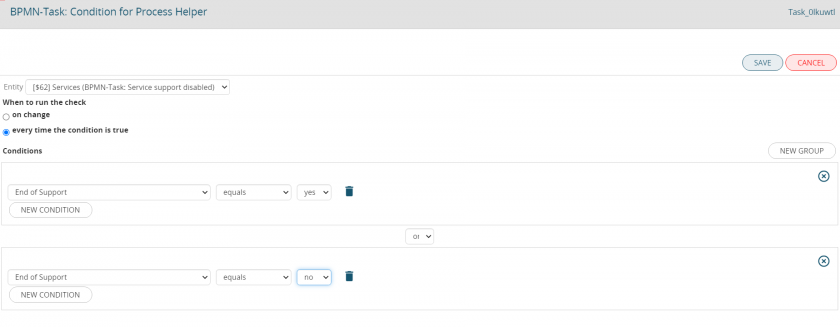](https://usermanual.vtenext.com/uploads/images/gallery/2021-08-Aug/Basic-Process-Configuration_-assignee-pop-up_3_2_configuration.PNG)
For the correct visualizzation of the pop-up is needed a “conditional task” after the user task. Inside this task are set two group conditions on the new field ( End of Support). These two conditions will be used in the next step.
[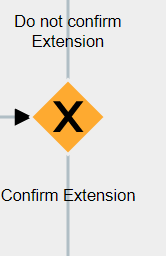](https://usermanual.vtenext.com/uploads/images/gallery/2021-08-Aug/Basic-Process-Configuration_-gateway_4.PNG)
[](https://usermanual.vtenext.com/uploads/images/gallery/2021-08-Aug/Basic-Process-Configuration_-gateway_4_configuration.PNG)
At this point the process reach gatwey here the process can potentially take two braches depending on the choice made by the assigne: If the assignee choosed to don’t extend the support service each contacts, related to that service, will be notificed with an email; on the other hand if the assignee choosed to extend the support date the service record will be update with the new date indicated by the asignee.
**1 case the asignee of service do not confirm the support service extension**
**[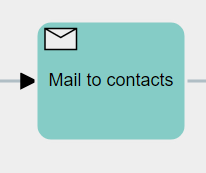](https://usermanual.vtenext.com/uploads/images/gallery/2021-08-Aug/Basic-Process-Configuration_-mail-to-contact_5.PNG)**
The process will send an email to each contacts related to that service. This action is made with the action cycle related records, starting from the module service the process cycle to each single contact and it send email.
[](https://usermanual.vtenext.com/uploads/images/gallery/2021-08-Aug/Basic-Process-Configuration_-mail-to-contact_5_configuration.PNG)
[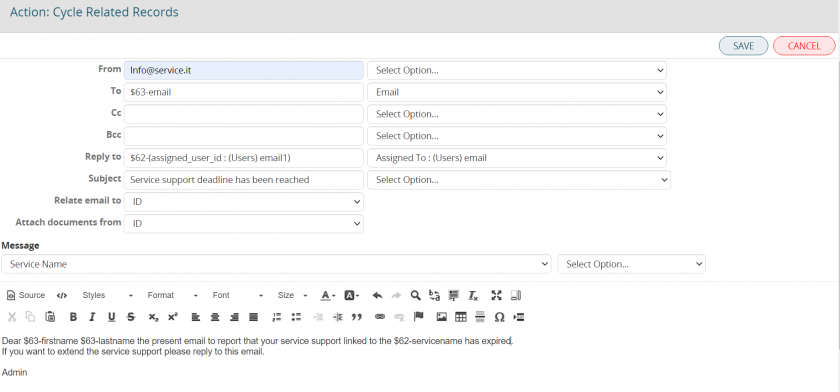](https://usermanual.vtenext.com/uploads/images/gallery/2021-08-Aug/Basic-Process-Configuration_-mail-to-contact_5_configuration_2.PNG)
**2 case the asignee of service confirm the support service extension**
**[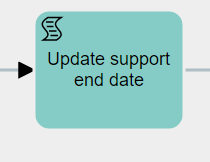](https://usermanual.vtenext.com/uploads/images/gallery/2021-08-Aug/Basic-Process-Configuration_-update-support_date_6.PNG)**
In this case the support date will be updated with the value that the assigne passed in the process helper step. In this step is used the action update entity with the Renwal date mapped to the field support end date.
[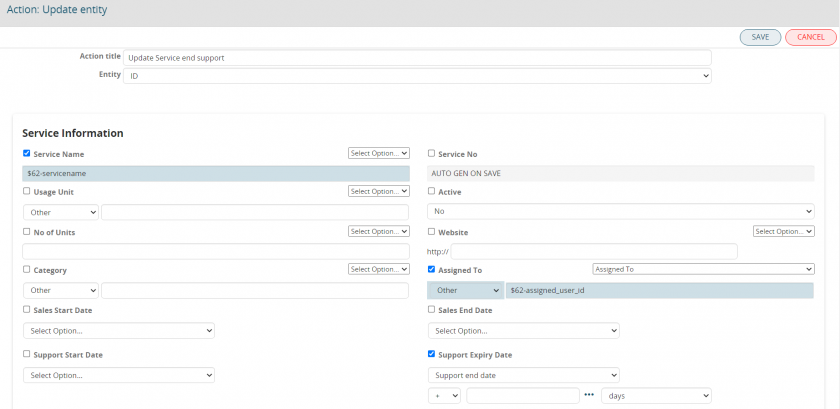](https://usermanual.vtenext.com/uploads/images/gallery/2021-08-Aug/Basic-Process-Configuration_-update-support_date_6_configuration.PNG)
In the end the last task (end event) is configured as shown below:
[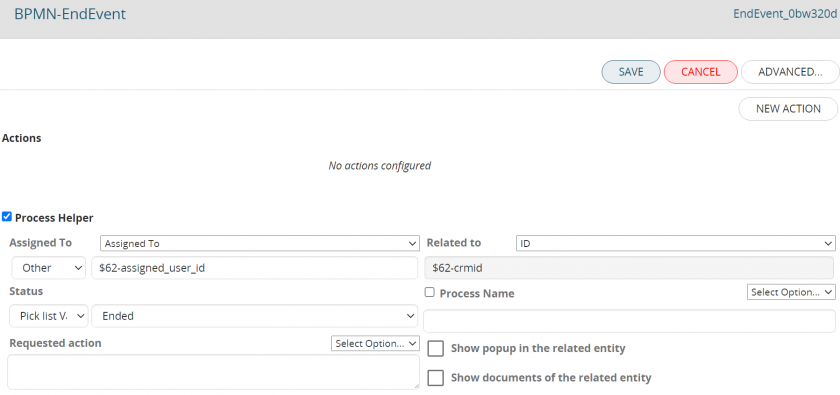](https://usermanual.vtenext.com/uploads/images/gallery/2021-08-Aug/Basic-Process-Configuration_-end_event_configuration.PNG)
# Basic Process Activation
#### **PROCESS ACTIVATION**
We proceed by creating a new company record.
The Rating field, in this case, is set on Active, therefore a new potential should be created.
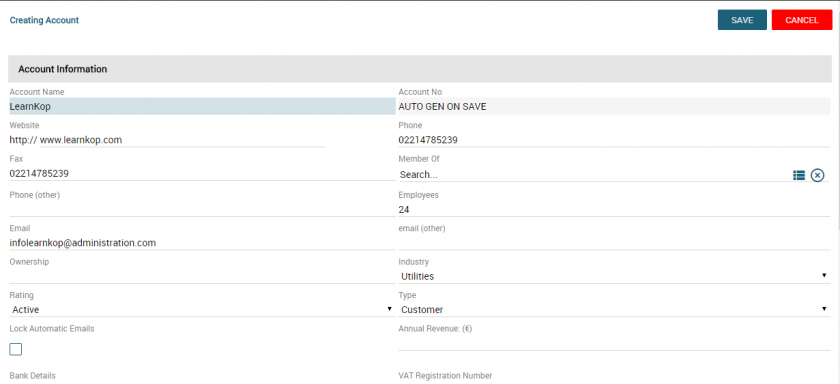
Once the record is saved we should find a New Potential related to the company itself, containing the name and data inserted in the related configuration. Here below we can see the details:


**The process ended its flow.**
We can notice this also by clicking on the tab “Process Graph” of the created company.
Looking at the graph we can define which path took the flow and where it stopped.
In this case the highlighted point, that is where the process stopped, is the End Event.

If the Rating field wasn’t active a recap email would have been sent to the email address reported in the module (Email field) and to the assignee of the record.
Here below you can find an example:
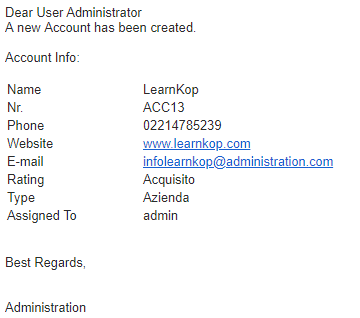
#### **PROCESS ACTIVATION - End of Support Service**
The process start when the service record is modified ticking the box “End Support” to the value “yes”.
[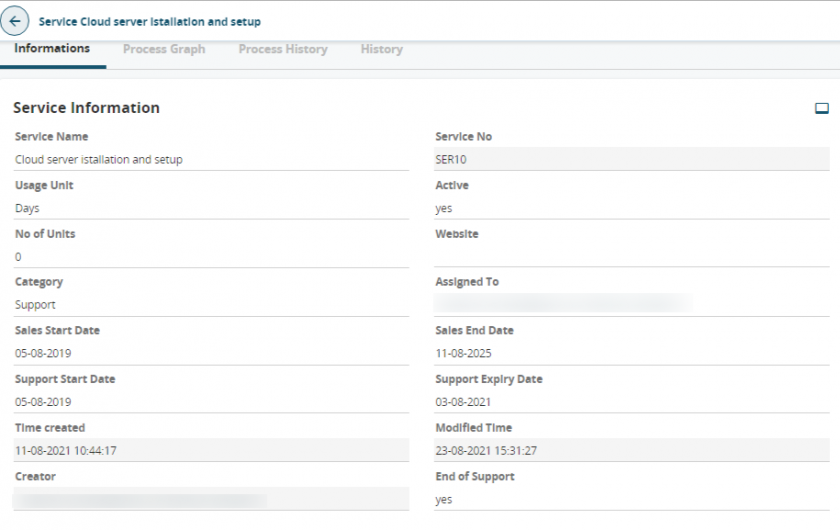](https://usermanual.vtenext.com/uploads/images/gallery/2021-08-Aug/Basic-process-Activation_-end-support_1_.png)
Once the record will be saved the following pop-up will appear to the asignee of that service:
[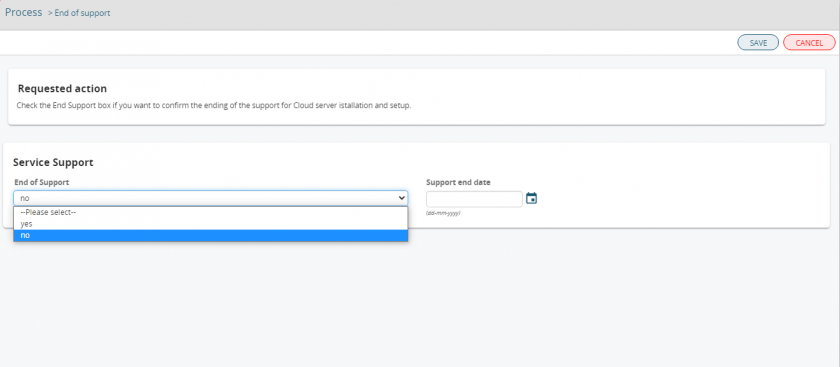](https://usermanual.vtenext.com/uploads/images/gallery/2021-08-Aug/Basic-process-Activation_-end-support_2_.png)
This pop-up will ask to the assignee of the service if he/she wants to extend the support end date. Through the drop-down menu the asignee will choose one the following options:
1\. No – unticked End of support box to confirm the end of the support.
2\. Yes – ticked End of support box to extend the duration of the service support
**1. NO - unticked End of Support box**
The expiry date is confirmed by the asignee of the service. In this scenario all the contacts related to that service will be allerted with an email.
[](https://usermanual.vtenext.com/uploads/images/gallery/2021-08-Aug/Basic-process-Activation_-end-support_3.png)
**2. Yes – ticked End of Support box**
The expiry date will change according to the one chosen by the assignee
[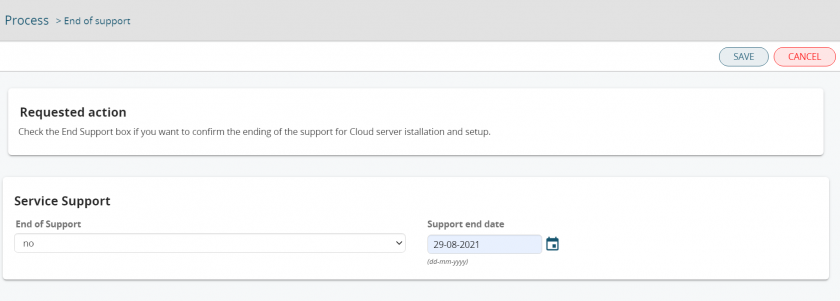](https://usermanual.vtenext.com/uploads/images/gallery/2021-08-Aug/Basic-process-Activation_-end-support_4.PNG)
In this case, after saving the record will be updated with the new end support date provided by the asignee
[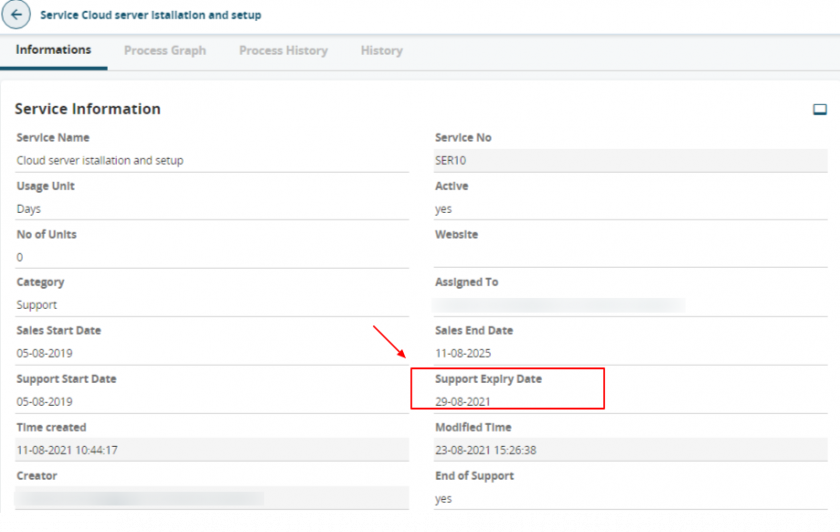](https://usermanual.vtenext.com/uploads/images/gallery/2021-08-Aug/Basic-process-Activation_-end-support_5.png)
# Advanced Process Configuration - LEAD MANAGEMENT
# Advanced Process Configuration - LEAD MANAGEMENT

Once the process is graphically designed we work on the interface. Below we can see, step by step, how the configuration is done. In the chart below is reported the process flow for the lead management.
At the moment of its creation the Admin User will define whether to reassign it or to do it later, according to various conditions, it will check if the lead has been taken in charge or not.
In the screen shot is possible to display the process.
To activate it you have to tick on **“Active”** once the chart and the configuration is terminated.

---
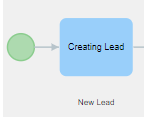
Here at side the first task that checks the lead is filled, by clicking on the task is possible to display the window
below. In “Entity” is possible to choose the module, the Leads one in this case. On “when to run the check” we tick
**- “at creation”.**
In conditions we set the one that will determinate the action, in this case that the Surname field is not empty
(condition necessary for the management).

Before proceeding with the explanation of the configuration we see in detail the options. When to run the check:
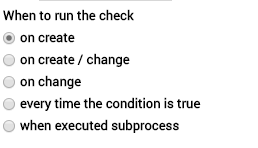
**It is important to take in consideration that, for the first three options, a manual action by the user is needed, in the last two it is not.**
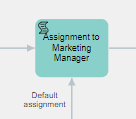
In the event that we choose to create an action not using the Process Helper is necessary to flag its box. We will later see both procedures.

In the action task window, see above, there are two possibilities: Actions or Process Helper.
In the Action configuration we give instructions to the system so it can proceed automatically with the flow, no manual intervention is needed, those are instruction given to the software. Clicking on new action we can, using the pick list, choose if:
- Send an email or a programmed newsletter;
- Create, Update or Delete an Entity;
- Reset dynamic forms or conditional fields;
- link entities;
- call External Web services;
- we use the Process Helper only when a manual intervention is needed.
In this Task an “Update Entity” action is created in order to assign the lead to the administrator. Therefore we select New Action and then Update Entity, we choose the module, the Leads one, and we select the field that has to be updated.
In this case the field is “assigned to” as we can see below:

---
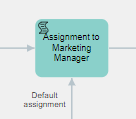
Now a manual sorting is needed to go on with the process, therefore is necessary to use the Process Helper.
Ticking on the box we have to fill:
- **- Assigned To** Here we choose “Admin User” that is in charge of sorting the Leads.
- **- Related to** The desired module
- **- Status** That can be Running, Waiting or Ended.
- **- Instructions** Instruction for the user that has to perform the action.
The data for the dynamic form management can be filled in the Process module or directly in the selected entity by ticking “Show pop up in the related entity”.
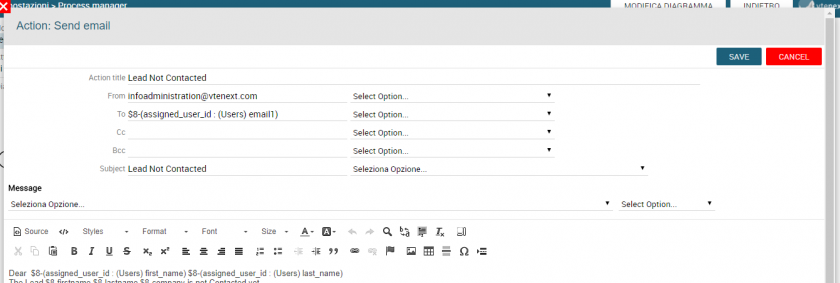
In the previous slide, using the Process Helper, we have added specific information regarding the process.
It is possible to create dynamic forms with specific blocks and fields, that will be filled during the flow, those information will be reported in the process but not in the modules’ records.

In this example, we ask the assigned user, through the process helper, if is needed to reassign the lead with the chance to select the new assignee and confirm the action using the check-box “Re-assigned?”.
Furthermore, some fields of the Lead record are in read-only mode.
This configuration and the default value are set by clicking on the pencil of every field.
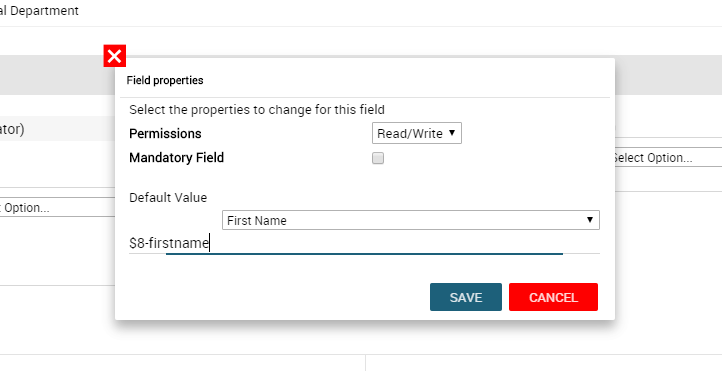
---

The next task is the condition “Check Assignee”, to reassign the lead to a new user. With this task, that goes on with a gateway, the process is divided in two different paths. In the first the lead is assigned to the new user, in the second the lead is still assigned to the original user. In this event the check is run on change because a check-box already has a default value (false). Every flow is represented by a group of conditions. The user intervention is therefore needed.
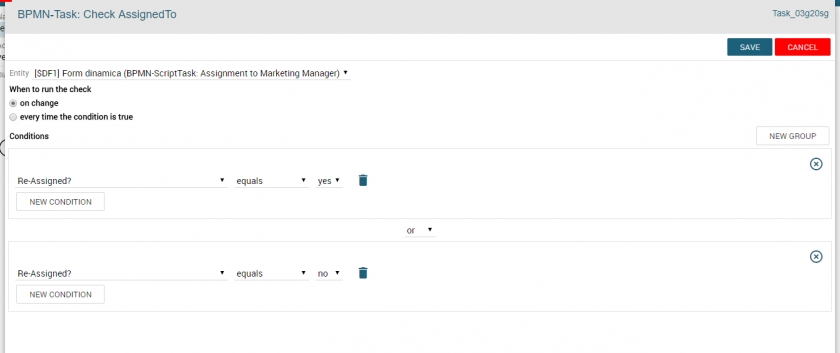
---
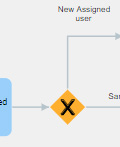
In the Gateway the flow is divided in two paths, if the lead is reassigned it will take the “New Assignee” direction,
otherwise, if its not changed, it will take the direction “Same Assignee”.

---

This task is an action script that assigns the lead to the new selected user. We click on “New Action”, here we chose update entity, to reassign the lead to the new user. In this situation there is no need for a manual action, we proceed by creating an automatic procedure by giving the instruction to the software.

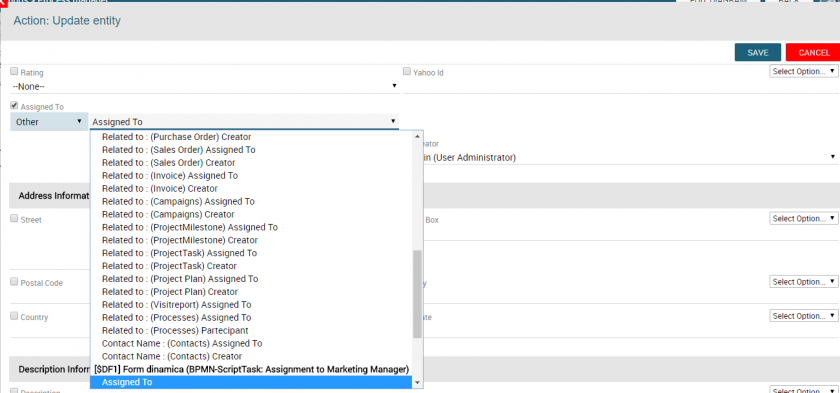
Once clicked on the pencil symbol the following screen opens, it contains the fields of the chosen module, the Leads one in this case. Using the fields we will give the instructions for the actions.
Here we want to update the field “Assigned to” with the new selected user by selecting “Other” and the desired value from the pick list.
---
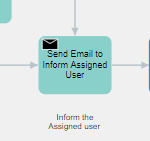
At this point the two paths will be reunited by the same action, the email sending to the assignee of the Lead.
Summing up, whether the Lead has been reassigned or not, the mail will be sent to the user in charge.
So we create a New Action --> **Send Email**.
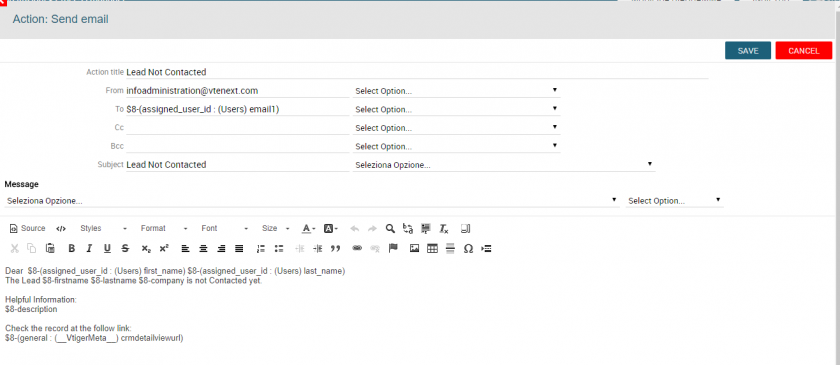
Along with the Email sending, other advanced settings are configured.
At this point of the process we want some fields to be in “read only” mode.


Using this page we can manage the Identity fields:
- **Set a default value**
- **Read only mode**
- **Read/Edit mode**
- **Mandatory**

---

At this point the process stops and waits for a condition to occur. This condition occurs when the field “Lead Status” changes.
Now we set the different paths that the process can take.
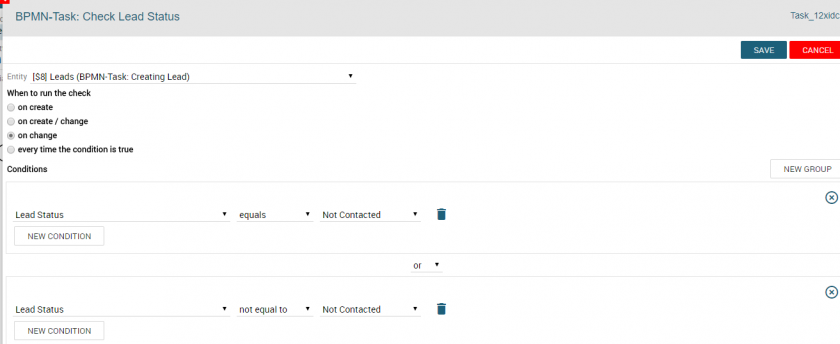
---

Once again using the Gateway we define the paths on the basis of the conditions decided in the previous box.
Here the flow changes depending on the **Lead Status**:
- **“Not Contacted”** - The Lead wasn’t managed by the assignee therefore the Sales Manager has to be alerted.
- **“Other Status”** - The process continues with the following steps later described.

---

At this point there is a pop up that helps the assignee to create an event of reminder.
Once again we use the Process Helper with the following fields:
- **Date (Start Date, End Date)**
- **Time (Start Time, End Time)**
- **Text (to name the reminder)**
This step requires the user intervention.
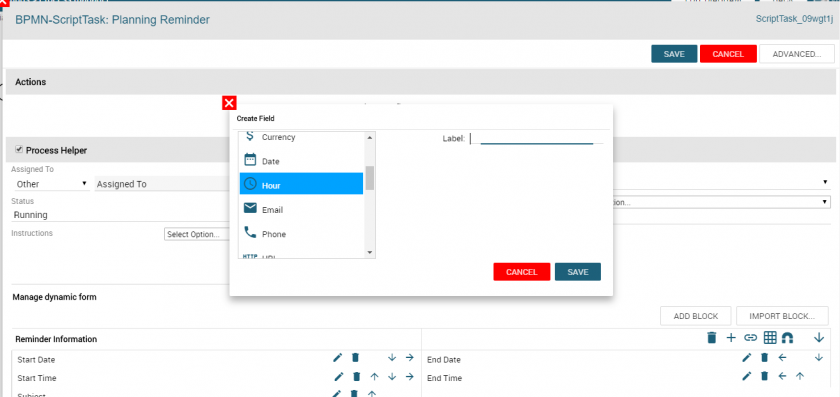
---

We check the data to verify that the user has filled all the necessary fields. (date, time, name).

---
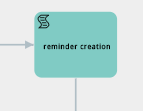
In this Script Task a new entity is created, the Lead’s reminder, which has been updated with a Status different
from “Not Contacted”. The user will display in its calendar the created event with date, time and text.
**New Action ----- Create Entity ------ Event Module**
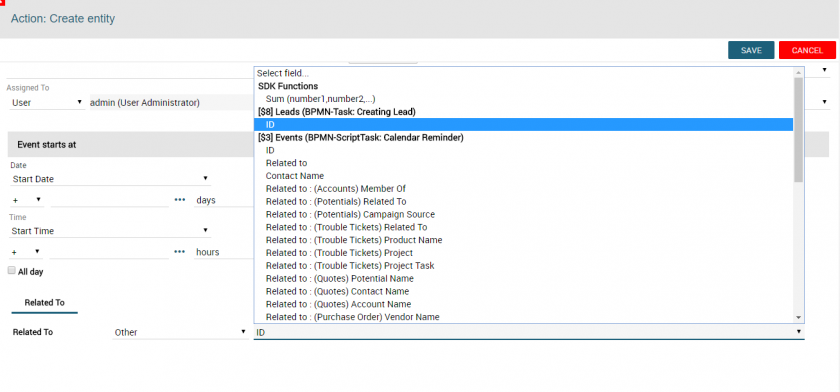
---

Now the process waits until the user changes the event status to held. This means that the lead has been managed.

---

n this Task a linking action is performed. If the process reaches this point it meas that all the conditions have been
satisfied and therefore the Lead has to be linked to an existing Target.
We create a new action, “Link static entities”, and then clicking on the desired module (Target in this case) and the
related record.
The difference between “Link entities” and ”Link static entities” is:
- **“Link Entities”**: links two entities contained in the process
- **“Link static entities”**: links an entity contained in the process with one that is not, but is contained in a record of a preexisting module.

In this case we link the Lead record involved in the process with a static entity, “Targets”, by selecting the desired record.

---
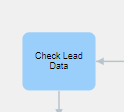
At this point, to maintain a correct flow, we create a condition regarding the Lead.
This condition is not mandatory for the flow to go on, but it is recommended since the following element is a Timer, so to avoid too many sequential actions.

---

As previously said, this is a Timer (Intermediate CatchEvent – TimerEventDefinition). It allows to put in hold for minutes/hours/days the process before proceeding with the following Task.
Here we wait 5 days to check if the lead has been managed or not.
[](https://usermanual.vtenext.com/uploads/images/gallery/2021-08-Aug/Advanced-Process-Configuration---LEAD-MANAGEMENT_-intermediate-catch-event.png)
---

Once the time is up the flow proceeds with the following Task, a Condition Task in this case, designed to check if the field “Description” has been filled.
This is done to understand if the lead has been managed or if it needs to be reassigned.

---

Now we draw a **Gateway** to divide the flow. If the Description field has been filled the process ends, if not the reassignment process begins.

---

In the example below the “Description” field has been filled and so the process end with an End Event by setting the process’ status on “Ended”.

---

In the other case, if the “Description” field stays empty an automatic email is sent to inform the assignee
that the Lead wasn’t managed.

---
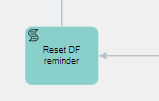
At this point the process restarts all over again. Therefore all the data placed in the dynamic forms will be erased.
In our case the concerning data are the one contained in the reminder’s dynamic form.
Furthermore the event previously saved is automatically deleted since, with the new flow, another one will be created.
**New Action - - - - Reset- - - - Dynamic Form**

From here it is possible to select the Dynimic Form we want to reset.
Two actions are therefore created:
- **Reset Dynamic Form “Create Reminder”**
- **“Delete Event entity”**


---
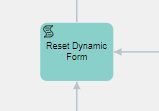
Even the data regarding the first dynamic form are reset, that is to say the pop up that reassigns the Lead to the user. Moreover the conditional fields previously set are restored. Now we go back to the original setting, without data in “read only” mode.


---

This Task represents the second path, where the Lead’s status is “Not Contacted”.
For sure if the status is “Not Contacted” it won’t be contacted anymore, so the admin user is notified with a pop up of the situation with the chance to confirm or not the ongoing situation.
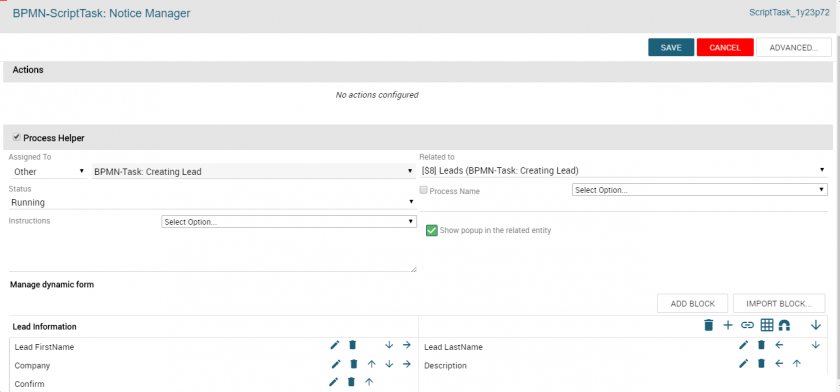
It is possible to manage all the dynamic form’s fields by clicking on the “Advanced” button and then on “New Rule” in “Conditionals on dynamic form”. From here we choose the settings of the fields, for example read only, mandatory, etc.


---

If the condition decided by the admin user occurs the process goes on with the following Task.

---

In this Task an email with the relevant data regarding the non contacted lead is sent. After that the process ends with an End Event.
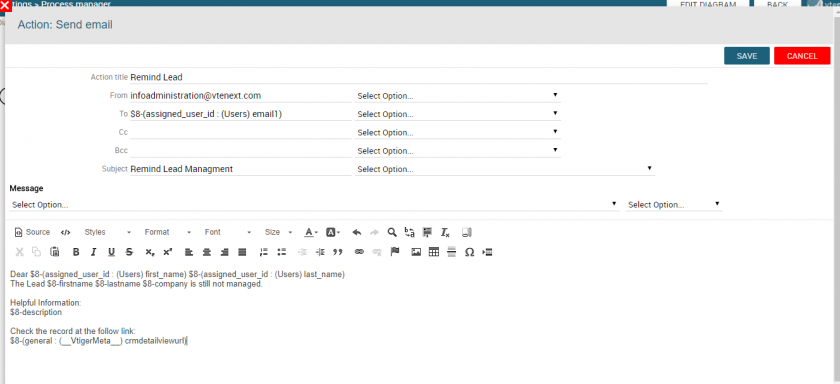
# Advanced Process Activation - LEAD MANAGEMENT
Once enabled we run a check, we go to the Lead module and we create a new one. As pictured below, to enter the process is necessary to respect all the conditions. Here it is foregone since the initial condition is the Surname field not to be empty (which is also a mandatory field).
Once the lead is saved the process will begin.
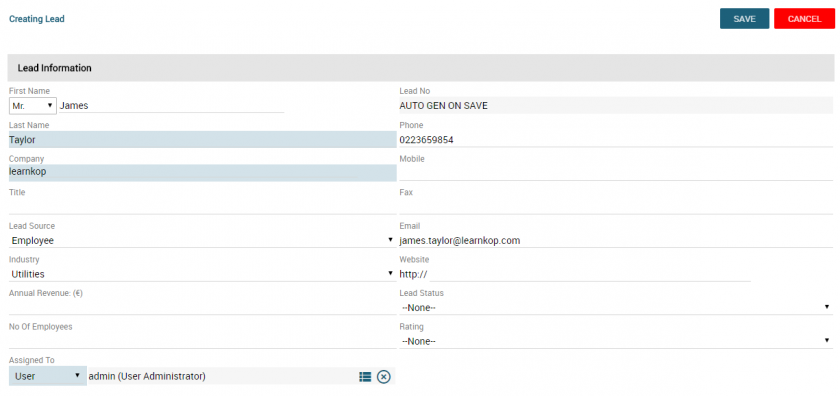
The process starts and the first pop up will appear the admin user has to decide if the Lead has to be reassigned or not.
To reassign the record select the desired user and then flag the “Reassign?” box.
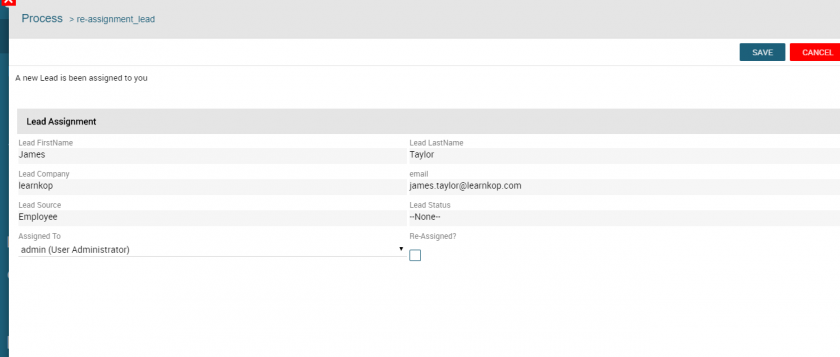
Once the assignee is decided an email containing all the relevant information will be sent.
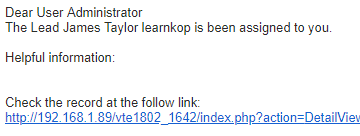
We now go on with the following Task, that will check the Lead’s status.
Some fields of the record, like Name, Surname and Lead Number are set in “read only” mode.
Now, if the Lead status is different from “Not Contacted”, the process will take the path that creates a remind event.
**Here below you can see the changing of the status.**
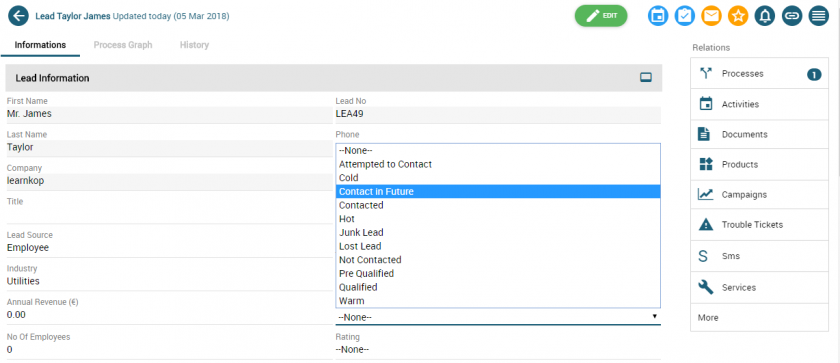
Later a pop up, to set all the data regarding the reminder event, will appear. Among those data we can find Date, Time and Name (of the reminder).

Once saved, in the Calendar an event with the given information will appear. Clicking on it, it will be possible to display all the related
information.
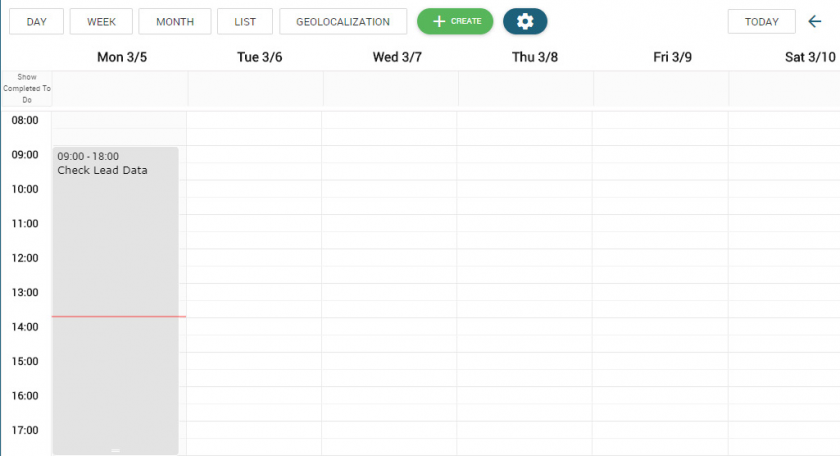
Clicking on the event box all the details will be shown.
When the status will switch to “Held”, the process will follow the flow.
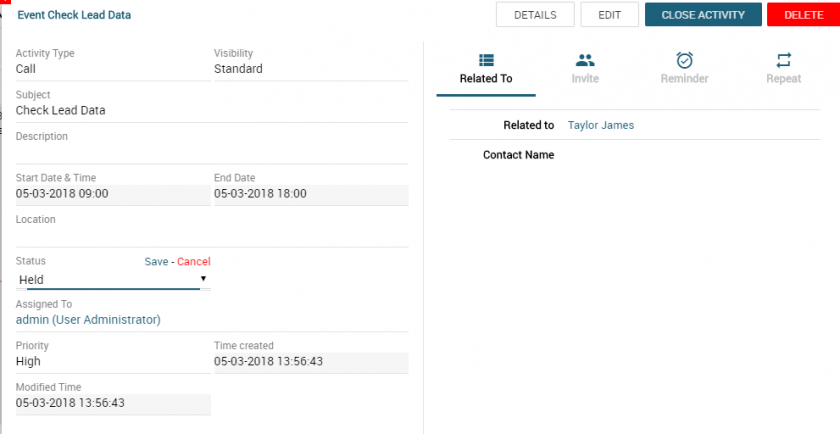
Once the status is on “Held” the Lead will be inserted in the Target previously set in the Related List. Clicking here it is possible to display all the details.
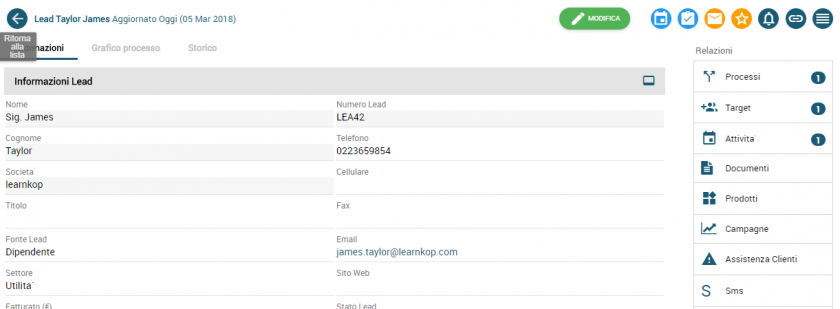
From the Process Chart (Process Graph tab), it is possible to note that the process will be put on hold for 5 days, before checking if the Lead description has been filled or not.
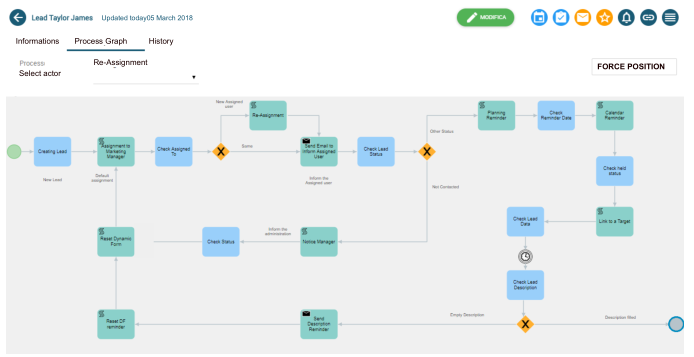
If the Description field is filled within 5 days the process ends, because the Lead has been managed by the user in charge. If not the process will take a different path.
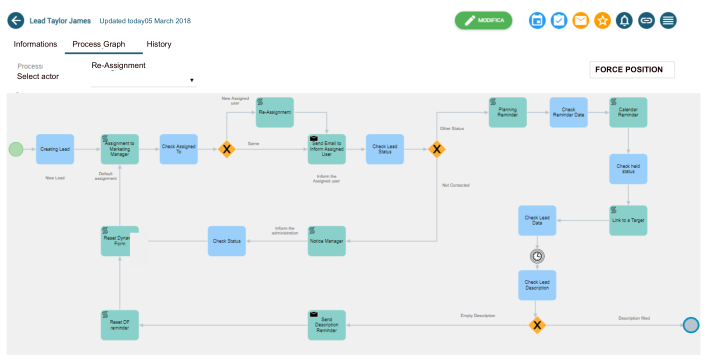
The other path of the Gateway contemplates the sending of a reminder email, like the one below:

After that, the dynamic forms will be reset and the event of remind deleted, since the process will restart with a new
reassignment and so with other possible reminder.
Now the admin user has to decide whether to reassign the Lead or to manage it.
If the lead is reassigned and its status becomes “Not Contacted”, the process will follow a different path, where the admin user will be informed of the situation.
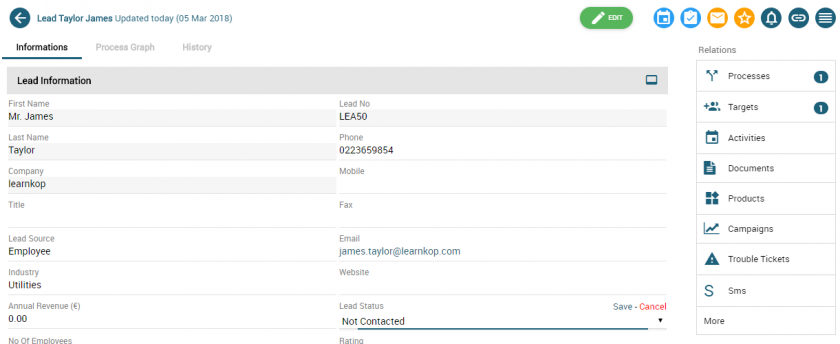
In the pop up below the admin user will confirm the situation and then an email will be sent to the assignee of the record.

**Next mail**
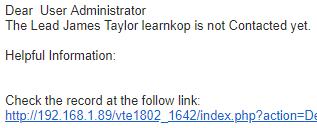
At this point the process ends.
**Among the new features:**
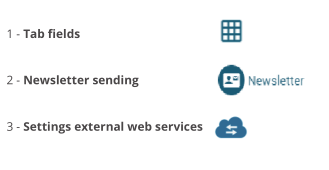
# Subprocesses
# Process Configuration - POTENTIAL MANAGEMENT
**Main Process: Potential Management**

We use the **Task Sub Processes** to create them, doing so we will simplify the logic behind the main process.
In the example below we will draw 2 Sub Processes:
- **1st Send a summary email** to the assignee and creates reminder event.
- **2nd Creates a pre filled Quote** (only if the previous conditions are true) and sends it via email updating the status of the Potential.

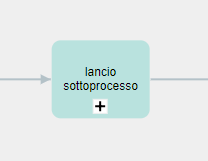
**Below you can display the configured process.**
The process is activated once a new Potential is created and follows the flow in order to reassign it or to change its status.
To activate it we tick **“Active”** once the chart and the configuration are ended.


On the left the first task, ore better the initial condition, has been created. Therefore we select the entity, **“Potentials”**, and we choose when to run the check **“on creation”**.
Then we state a Group of condition to start the process, in this case the Sales Stage has to be among the ones reported below (“Prospecting”, “Qualification”, “Budgeting”).

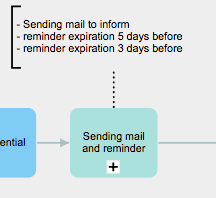
This task represents the link to a sub process, which follows its own flow. For this reason we need to chose the sub process to link. In the process selected there is contained an email sending task to inform about the creation of the potential and the creation of two reminders, one 5 days before the expiry date, and the other 2 days before.


This task represents a check on the potential’s status (Sales Stage). Here we define the **statuses that have to be managed**.
They are divided in two blocks:
- Prospecting
- Needs Analysis
- Perception Analysis
- Proposal/ Price Quote
- Negotiation/ Review
- Value Proposition
- Decision Makers
**OR**
- Close WON
- Close LOST
**The setting is displayed in the following page.**
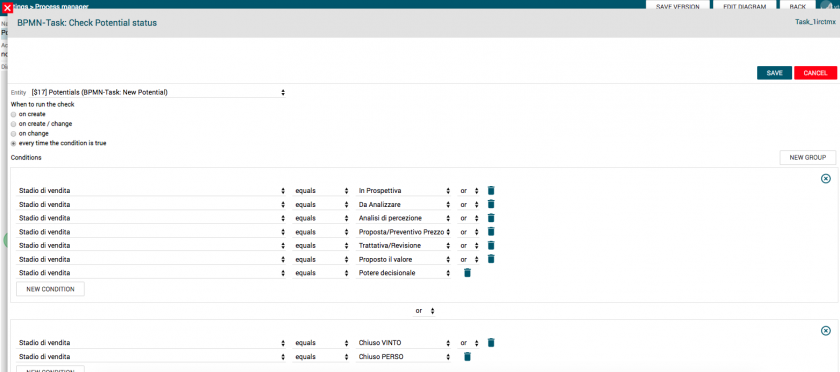
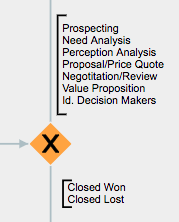
This task is an Exclusive Gateway, which defines the different flows according to the conditions previously set. In this case, if the Sales Status is among the ones reported earlier in the first block (Prospecting, Decision Makers, Negotiation/ Review etc) the process goes on with the task called “Change assignee request”. On the contrary if the status is one of the second block, **Close WON/LOST**, we go on with the Task **“Send Summary Email”**.


This task uses the **“ProcessHelper”** that talks with the user asking a manual intervention. We flag the box **“Show pop up in the linked entity”** to make a window appear (dynamic form) containing a set of data in read only mode as a recap and a user field in which a new assignee can be selected and a Button field in with which is possible to change the picklist value **“Confirm”**.
It is necessary to confirm to proceed.
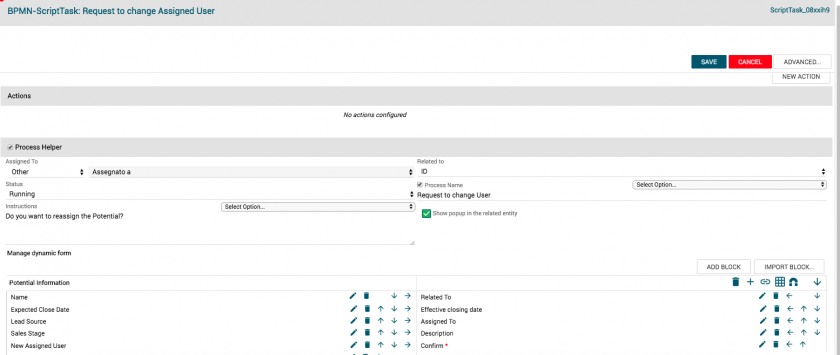
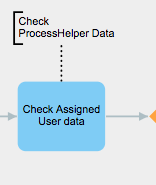
This Task checks the data of the Process Helper. As said, though a dynamic form some recap fields and a confirmation pick list are shown **(YES/NO)**, this defines the new reassignment.


In this point we use the Exclusive Gateway to decide which way the process has to take according to the answer given
in the Dynamic Form. If the user confirmed **(YES)** the process goes on by reassigning the Potential, if not **(NO)** the process checks its sales status **(Sales Stage)**.


The Task on the left performs an update action. The user previously chosen in the Dynamic Form will be reported in the Potential. Therefore we add a new action – **update entity**.
We select the Potential and we change the field Assigned to taking as reference the field contained in the Dynamic Form, that is to say **“New Assignee”**.

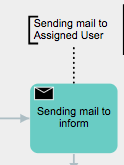
This task is the email sending that informs the new Assignee of the Potential. The user will receive an email containing a summary of the Opportunity.
In the email the process fills the mandatory field, that is to say: Sender, Receiver, Subject and Body.
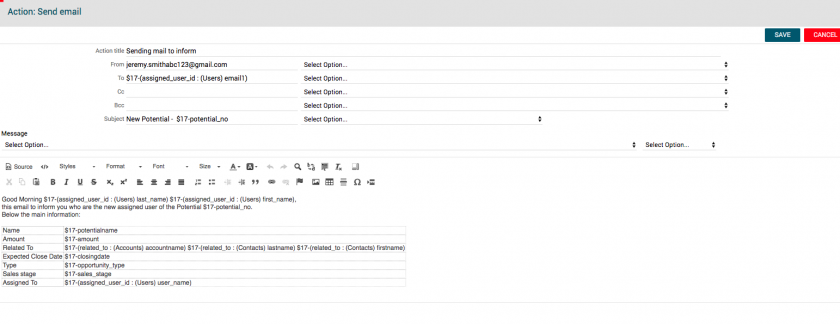

The task here pictured represents a second check on the Potential status (Sales Stage).
We define the possible status that have to be managed. In this case we check if the sales stage is equal to “Proposal
Price/Quote” or not.
If the result is a match we go on by recalling the subprocess “Pre filled Quote”, otherwise we go directly to the task
“Send summary Email”.


This task is another Exclusive Gateway, which defines the following steps according to the conditions previously set. So if the sales stage is Proposal Price/Quote to process goes on with the following task as previously said, that is by recalling the sub process “Pre filled Quote”. Otherwise it goes on with the email sending.


The task on the left represents a link to a sub process, which will create a quote and when its stage is changed in “Negotiation/Review”, will send an email and update the sales stage of the Potential.


We go in with a task that runs a check and the sales stage of the opportunity, to verify the complete execution of
the Sub Process. If it is equal to **“Negotiation/Review”**, the flow goes on with the next Task, the sending of an email
containing the final recap.

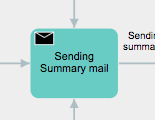
This task represents the last action, a summary email to inform the assigned user about Potential data.
Click on "New action" - Send email and then insert all needed fields.
After that, the process will be ended (End event).

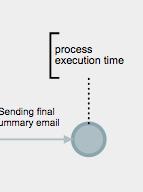
As said, the process ends with an End Event, to which is linked the **“Potential”** and the status is set on **“Ended”**.
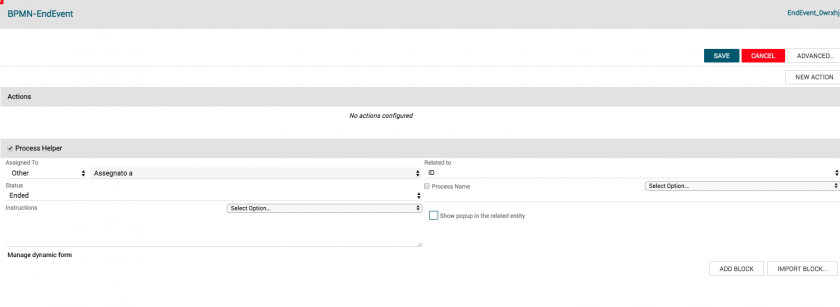
#### Subprocess: “Potential Expiry”
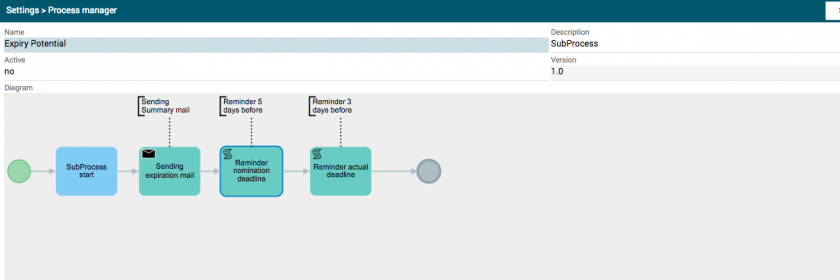

The Task represented is the initial one to launch the Sub Process. No entity is selected and on **“When to run the check”** we select **“When executed subprocess”**.
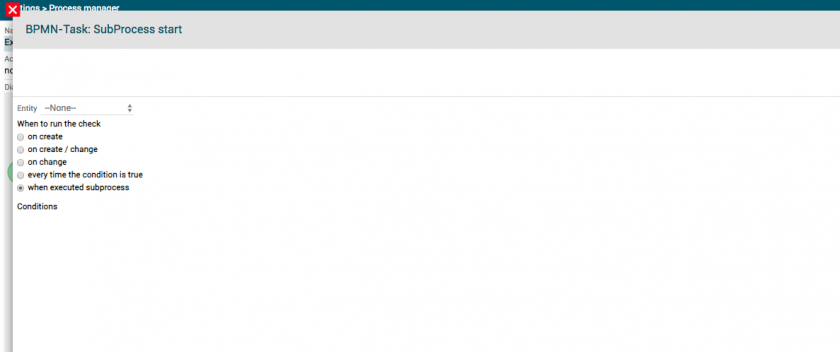

In this Task the email sending to the assignee of the Potential is configured. We chose **New Action – Send Email**.
We enter the main information (sender, receiver, subject, body..)

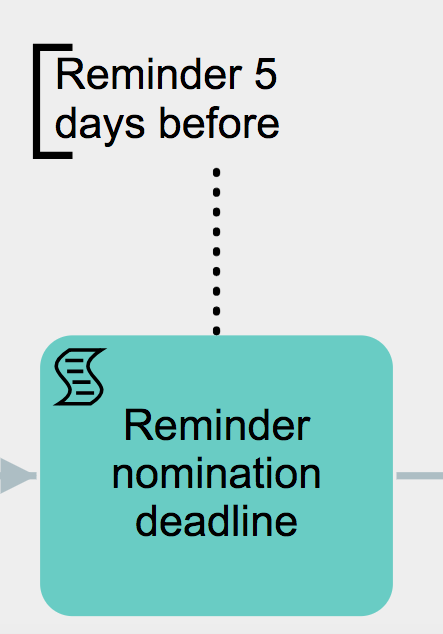
On the left we can see a task used to create a reminder, that is a calendar event close to the expected expiry date.
The event is planned 5 days before the **“Expred Close Date”** reported in the Potential.


In this Task we see the creation of a second reminder event. This, unlike the first one, is planned tree days before the expected close date reported in the Potential.
Therefore we fill the various fields as indicated and we subtract 3 days from the indicated date.

#### Subprocess: Pre Filled Quote


As seen in the previous Sub Process, we find the start Task to begin the process. In fact we don’t select an entity and on **“When to run the check”** we select **“When executed subprocess”**.


In this Task we configure a New Action – Create Entity, then we select the **“Quote”** module to create a pre filled one.
We place the title of the action and the various fields, we also link the Potential and we set the expiry date in 30 days.

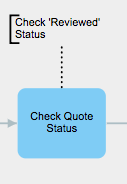
At this point the Sub Process blocks the execution flow on the Task described below.
We wait until the Sales Status of the Quote related to the entity previously created is changed in **“Negotiation/Review”**.
Only when this condition is true the process will proceed.


Once the quote’s status is changed in **“Negotiation/Review”** the process goes on and sends the details to the related entity (Account or Contact) with the assignee in copy.


Now we update the Sales Stage of the Opportunity in **“Negotiation/Review”.**
**At this point the Sub Process ends.**
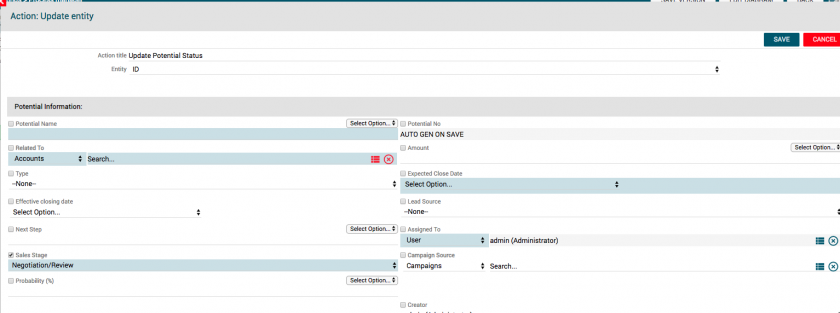
# Process Activation - POTENTIAL MANAGEMENT
**PROCESS ACTIVATION**
At this point we completed the configuration of the process and sub processes. Therefore we proceed by checking the proper running of the process.
**Now we create a new Potential.**
In this case we set the Sales Status on **“Open”**.

Once the Potential is saved the Assignee will receive a mail containing a summary of the data.
In addition, there will already be 2 related events, ie deadlines, one to 5 days from the expected closing date and the other to 3 days from the effective end date.
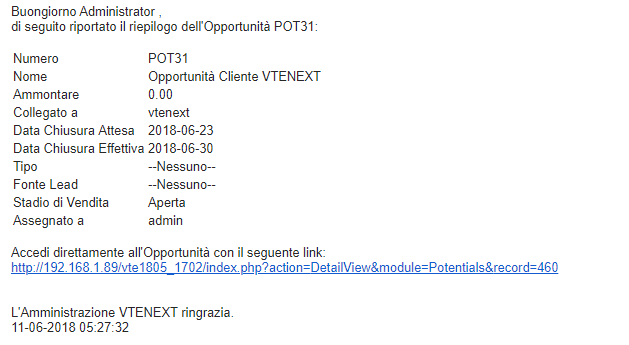


At this point the process is blocked until the Sales status changes in one of the stages previously configured.
Here we chose the status **“Proposal Price/ Quote”**.

Once saved, the assignee of the Potential will display a pop up containing a recap of the data in read only mode, it will also have the chance to re assign it to another user.
Once the desired user is selected we chose the **“Yes”** value in the pick list (it is possible to click on the button **“Confirm/delete”** to change to value of the pick list on Yes/No) and proceed by clicking on **Save**.
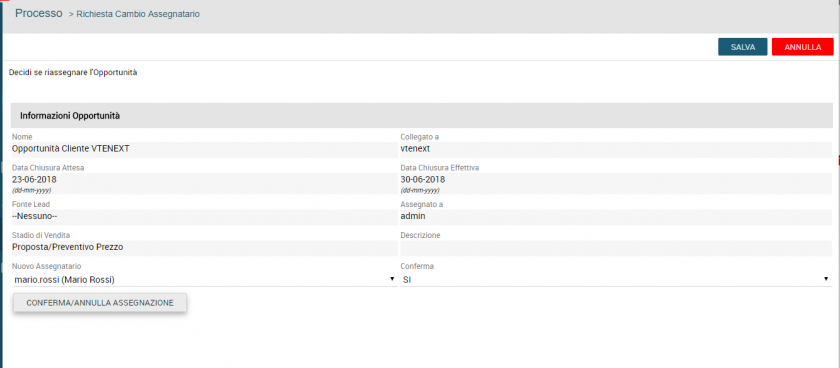
Once confirmed (by selecting the Yes value in the pop up) the assignee of the Opportunity is updated and will
receive an email containing its data. By looking at the relations we can see the email sent and the created Quote, because the status was “Proposal Price/ Quote”.


By looking at the relation with can see the details of the Quote.
At this point, we can open the record of the Quote, change the data, enter new products and change the Status on **“Reviewed”**.


The process goes on by sending an email to the assignee containing the data of the Quote.
Furthermore, the Sale Status of the Potential is set in **“Negotiation/ Review”**.


At this point the assignee receives an email containing a final recap of the Potential.
From the **“Process Chart”** tab we can see that the process has finished the execution flow.


# SDK
The documentation is not yet ready, you can see the Italian version.
# How to use Advanced BPMN Actions
1 - Table field
2 - Send newsletter
3 - Web service integration
# 1 - How to create a Table field
**Table field use**
This type of field allows to have more type of fields in it.
It is displayed as a table formed by N columns (depending on the number of fields configured) and N lines (depending on the number of lines the user decides to add). It is useful to store more information in one field.
Here below we can find and example.
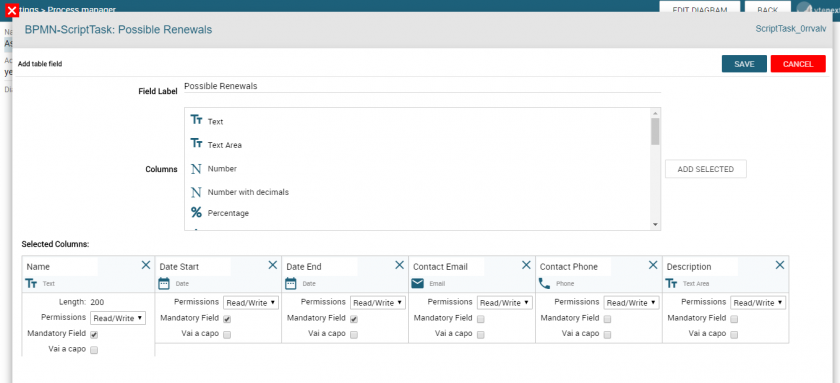
First we proceed by creating a new table field in the desired module.
In this case the field will be used to manage the Asset renewals, therefore it will be created in the corresponding module.

Once the table field is created the configuration window above will open.
At this point, is possible to add and name the different type of fields in it (Text, Number, Date…).
In this case for each line 6 fields will be present (Text, Date, Email, Telephone, Text Area), 3 of which are mandatory.
# 1 - Basic Process configuration - Installation renewals

Let’s proceed with the creation of an easy process to manage the renewal of an Asset.
When an installation expires the user will switch the Status to “Out of Order”.
At this point the process will begin.
An eventual renewal will be notified to the user in charge through a pop up.
Once one ore more renewals are inserted the record will be updated.
Below you can display the process.
To enable it tick the “Active” box, once ended the chart and the settings.

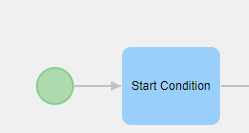
This is the first Task of the process.
As previously said, this must be a Condition Task in order to define the starting entity and its starting features.
In this case the starting entity is the Asset module and the process will begin when the record status will be set on “Out of Service” and a previous renewal is not present, that is to say renewals lines (Table field) equal to zero.
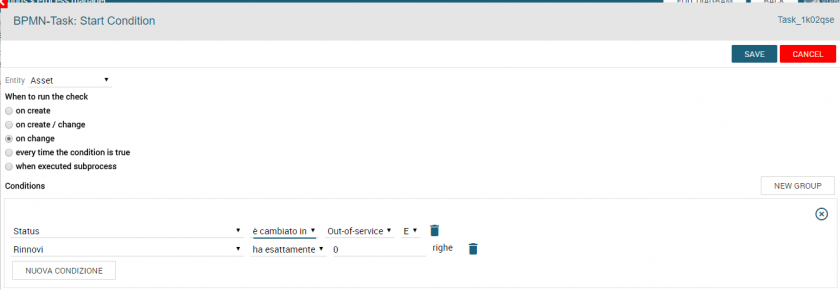

In the following Task, ScriptTask, the Process Helper is set in order to show the pop up to the assignee for possible
renewals.
It is then assigned to the latter by “picking” the assignee of the module from the picklist, we link the entity Assets (related ID), we select the checkbox “show popup in the linked entity” and we include a block with the desired fields. In this case there are two fields:
- **Table field with the same fields as the one previously created**
- **Note field for any reports**


This is the table field shown in the pop up, the one that, once filled, will be updated in the linked record. In fact the inserted fields are the same as the ones created in the module.

At this point, we check if the user has filled the renewal fields. It is possible to check the number of lines inserted,
for example “minimum one”, or check, like in this case, if the user has inserted the renewal notes.
The reference entity it’s the dynamic form previously set.
The process is on hold until that condition is true.

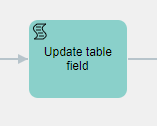
Once the conditional Task is done we proceed with the update of the renewal/s.
Therefore we create a Script Task with a Cycle type action.
We cycle the number of line inserted in the dynamic form (Possible Renewal field) and for every line “Add tab line” in the field “Renewal” created in the module.
Doing so the lines inserted in the pop up will be reported in the record.
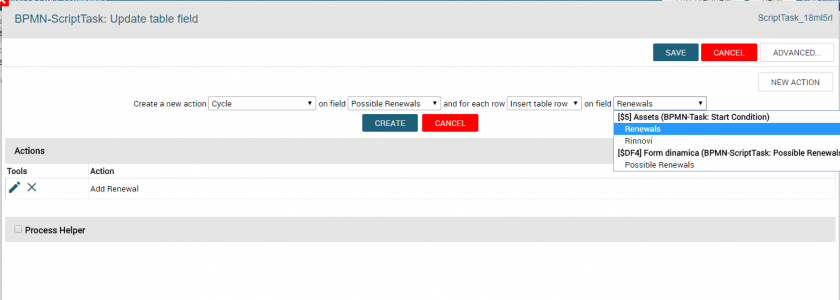
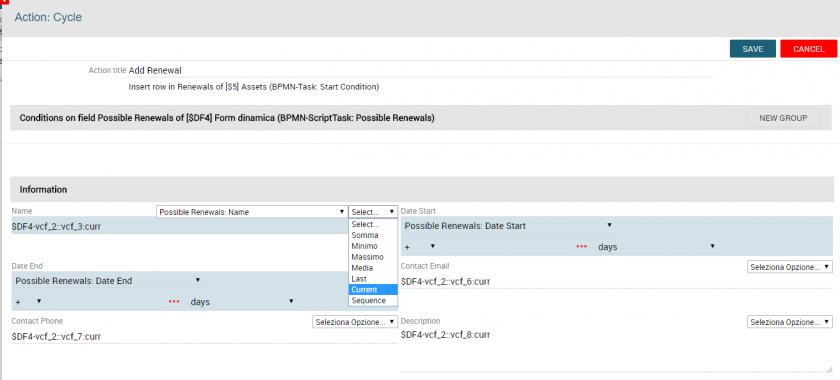
Now we proceed by updating the existing fields.
For each of them we take the entity contained in the Dynamic Form and we select the value “Current” in the pick list, in order to obtain the correct value for each line. Even if this is not the case, if we wanted we could for example obtain the sum or the average of different fields from different lines.

We complete the process by setting the End Event, changing the status in “Ended” and linking it to the entity (Assets).

# 1 - Basic Process activation - Installation renewals
#### **PROCESS ACTIVATION**
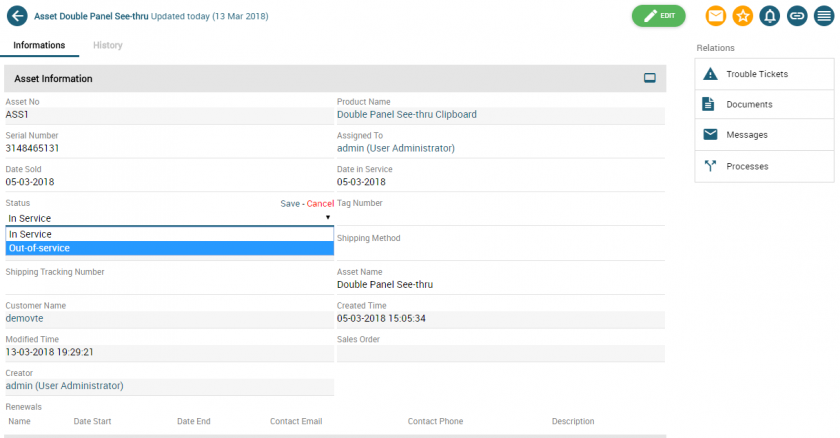
We can test now the process in action. There are no existing renewal and we set the Status field on “Out of Service”.

Now the assignee of the record will display a pop up with the chance to add one or more renewals.
In this case we add an annual renewal and we fill all the proposed fields.
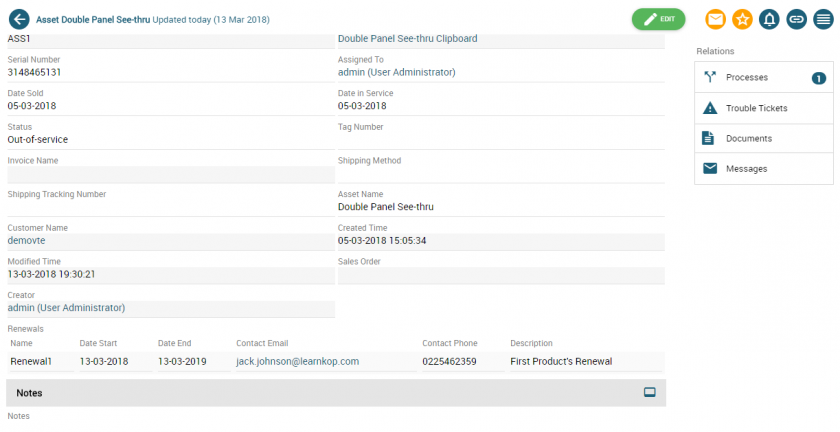
When saving a new line will be added in the field “Renewals”, and among the relates entities we will display the Process module.
# 2 - Send newsletter
#### **Newsletter sending**
It is possible to schedule the newsletter sending using the processes.
Doing so we can massively send emails to more addresses using preset template and campaigns (with the related target etc).


This is a Script Task. It was previously used in the process for the Lead management. After the link with the target a
newsletter sending is scheduled starting from an existing campaign.
**New Action --> Send Newsletter**


We now proceed by configuring this Task. We select a campaign, here we use an existing one (it is also possible to create a new one).
We select name and address of the sender and the receivers. In this case we select the “Partner Conference” target, doing so we take all the related email addresses.
Lastly, instead of writing the email it is possible to select a pre existing template (Email template es. Tell a friend about vtenext).
**Send newsletter.**

Here below is reported an example of the email received by the recipient of the email.
# 3 - Web service integration
**Web service integration**
Using WebServices it is possible to integrate different systems.
Using this function it is possible to receive data from external sources.
This is made possible by using set API that will give back json values, those will become variables that can be used within every process.
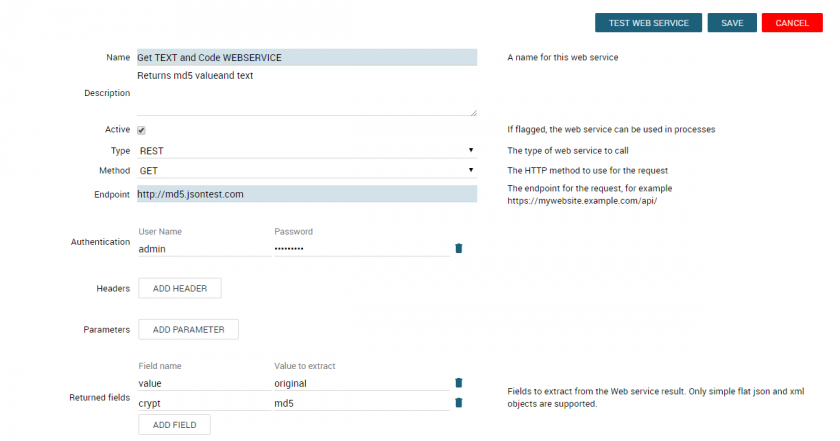
To exploit the potentialities of the Web Service first it is necessary to enter some fundamental parameters.
To do so we go to:
**Settings --> Business Process --> Manager External --> Web Services**
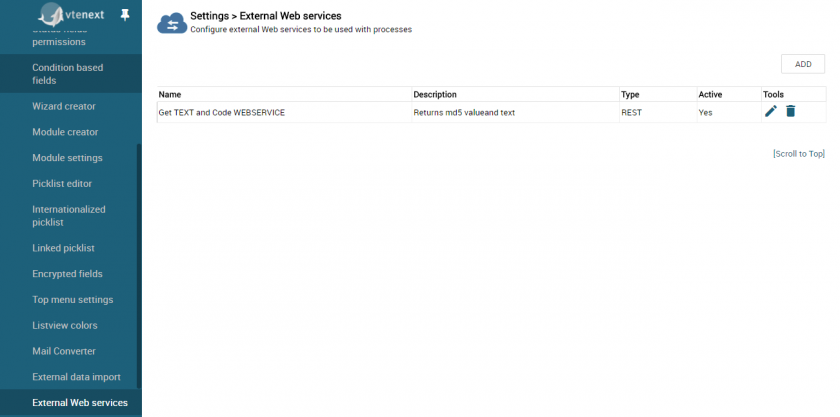
Clicking on “Add” it is possible to set a new Web Service with the desired parameters.
In this case we use http://md5.jsontest.com
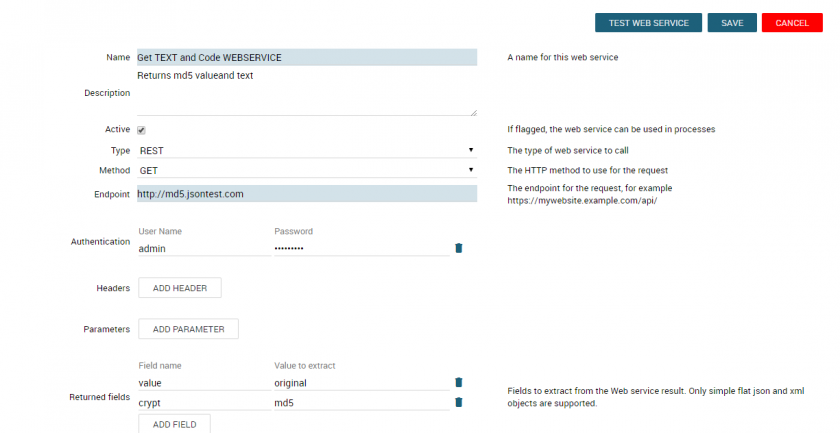
Once configured the desired Web Service it can be used in every process.
Let’s see an example:

- In the **first task** we recall the a Web Service set to become an actual entity of the process.
- In the **second task** the principal entity of the process will be updated with the data given by the Web Service itself.
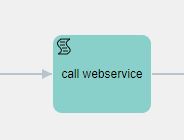
In this Task we set the use of the previously configured Web Service:
**New Action Call --> External Web Service**
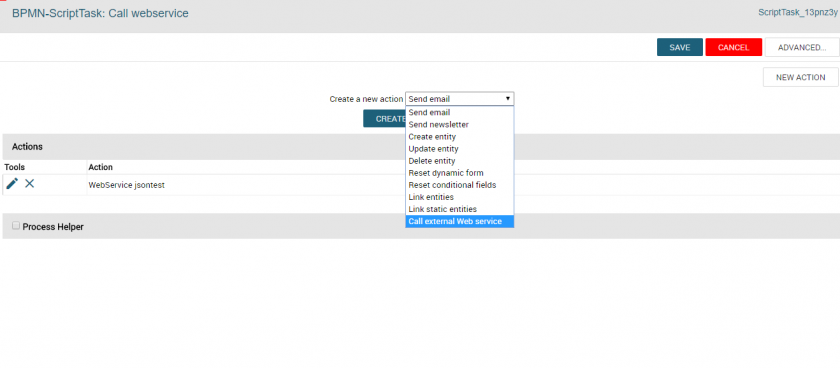
From the pick list Web Service we select the desired one and so all the related data will be displayed.
At this point it becomes an effective entity of the process. In the section Parameters it is possible to add dynamics values to pass to the URL.
The Parameter’s name and its value are indeed specified (it can be selected by the pick list “Values”.
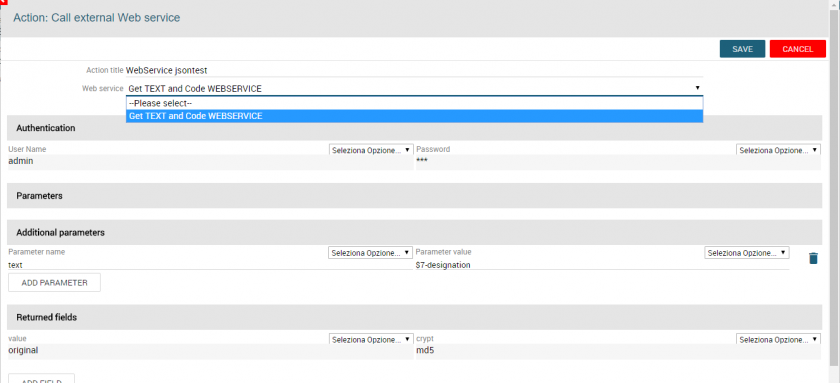
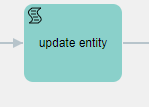
It is now possible to update any field of the selected entity with the values obtained by the Web Service.
Here we decide to update the field “Description” and so we select in the pick list the entity Web Service.
After that, we select one of the given field, in this case the “crypt” field is highlighted which gives back the md5
value.

